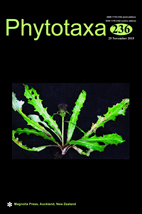Abstract
During the ongoing revision of Populus Linnaeus (1753: 1034) for the Flora of Pan-Himalayas, the application of the name Populus wilsonii Schneider (1916: 16) has been considered a complicated problem. P. wilsonii was described by Schneider based on Wilson’s collections from western Hupeh and western Szech’uan. In the protologue, Schneider cited E. H. Wilson 706a, May 20 and August 1907, Hsing-shan Hsien as types, which belong to two gatherings (cf. Art. 8.2 of the ICN, McNeill et al. 2012). Hao (1935) briefly reviewed Chinese Populus and cited E. H. Wilson no. 706a in Arnold Arboretum as the type of P. wilsonii, specifying in which herbarium the types were conserved, but not which of the two gatherings he designated as lectotype. We traced eight specimens of “E. H. Wilson 706a” in five herbaria: A, E, GH, K, US (Table 1). The two specimens kept in A (barcodes 00030875, 00030877) are labelled with Schneider’s handwriting “cotype, 20/5/07” and “type No. 8/07”, respectively, but both are composed of a flowering branch and a separated branch with mature leaves. These two specimens appear to be mixed gatherings, since most poplar flowers fade before the leaves unfold. Meanwhile, another specimen at K (barcode K000592058, image available at http://www.kew.org/herbcatimg/290165.jpg) labelled “E. H. Wilson 706a, 5/07 + 8/07” provided additional evidence that one sheet of E. H. Wilson 706a could be composed of material from different gatherings. Although the collection date was not identical to the protologue (May 1907 vs. May 20 1907), the E specimen of “E. H. Wilson 706a, 5/07” (barcode E00301557) was attached with an “Isotype” label and is supposed to be part of the gathering of E. H. Wilson 706a, May 20 1907. As a result, there are three gatherings under the same collection number: flowering female branches collected on May 20 1907, branches with mature leaves collected in August 1907, and flowering female branches with primary leaves collected in May 1907.

